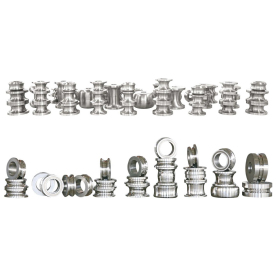****

Revolutionizing Manufacturing: The Role of High-Speed Pipe Making Machinery in Modern Industry
In today’s fast-paced world, industries are constantly looking for ways to improve efficiency, reduce waste, and increase production rates. One significant advancement that has emerged in the manufacturing sector is high-speed pipe making machinery. This innovative technology is transforming how pipes are produced, enhancing quality and productivity while decreasing costs. In this article, we will explore the various advantages of high-speed pipe making machinery, its applications across different industries, and future trends that could further influence the manufacturing landscape.
Understanding High-Speed Pipe Making Machinery
High-speed pipe making machinery is designed to automate and optimize the pipe manufacturing process. Using advanced engineering and technology, these machines can produce pipes at an unprecedented rate compared to traditional methods. The machinery typically integrates features such as automated feeding systems, precise cutting mechanisms, and advanced control software, enabling manufacturers to produce high-quality pipes in large quantities quickly.
One of the key components of high-speed pipe making machines is their ability to operate continuously without significant downtime. This capability allows manufacturers to meet increasing demands, especially in industries such as construction, oil and gas, and plumbing, where the need for durable and reliable piping solutions is critical.
Advantages of High-Speed Pipe Making Machinery
1. **Increased Production Efficiency:** The primary benefit of high-speed pipe making machinery is the substantial increase in production efficiency. These machines can produce a greater number of pipes per hour compared to traditional methods, which significantly boost overall output. This efficiency not only meets market demands but also allows companies to fulfill larger orders and explore new business opportunities.
2. **Enhanced Quality Control:** High-speed machinery often incorporates state-of-the-art technology that ensures consistent quality in the produced pipes. The automation of processes reduces human error, leading to uniformity in dimensions, thicknesses, and material specifications. As a result, manufacturers can uphold higher standards and comply with industry regulations more effectively.
3. **Reduced Labor Costs:** By automating the pipe manufacturing process, companies can reduce their reliance on manual labor, which in turn lowers operational costs. Fewer workers are needed to oversee production, and the need for extensive training is also minimized, allowing companies to allocate resources more efficiently.
4. **Versatile Applications:** High-speed pipe making machinery caters to various applications, making it a pivotal asset across a broad spectrum of industries. From producing pipes for plumbing systems to manufacturing pipes for critical oil and gas applications, the versatility of these machines enhances their usability and appeal across different sectors.
5. **Environmental Impact:** Modern high-speed pipe making machinery is designed with sustainability in mind. The enhanced efficiency reduces waste produced during the manufacturing process, contributing to a lower environmental footprint. Moreover, the ability to incorporate recycled materials into production can lead to a more sustainable manufacturing operation.
Applications of High-Speed Pipe Making Machinery
High-speed pipe making machinery has found applications in several key industries:
– **Construction Industry:** With the growing need for robust plumbing and drainage systems, construction companies rely on high-quality pipes produced quickly and efficiently to meet project timelines.
– **Oil and Gas Industry:** Pipes are integral to both transportation and infrastructure in the oil and gas sector. High-speed machinery ensures seamless supply and adherence to strict industry standards.

Revolutionizing Manufacturing: The Role of High-Speed Pipe Making Machinery in Modern Industry
– **Automotive Manufacturing:** High-speed pipes play a crucial role in various automotive applications, including exhaust systems and fuel lines, where precision and material quality are paramount.
– **Agriculture:** The rise of efficient irrigation systems has led to increased demand for durable and reliable pipes that can withstand harsh environmental conditions.
Future Trends in Pipe Manufacturing

Revolutionizing Manufacturing: The Role of High-Speed Pipe Making Machinery in Modern Industry
As technology advances, the future of high-speed pipe making machinery appears promising. Innovations such as Industry 4.0, artificial intelligence, and the integration of the Internet of Things (IoT) into manufacturing processes are expected to further enhance production capabilities. Predictive maintenance, real-time monitoring, and data analytics will become commonplace, contributing to even greater efficiency and reducing operational costs.
Additionally, sustainability will likely play a more significant role in shaping manufacturing practices. Companies will increasingly seek eco-friendly materials and processes, prompting machinery manufacturers to adapt to these evolving demands.
Conclusion
High-speed pipe making machinery is revolutionizing the manufacturing landscape by delivering efficiency, quality, and sustainability. As industries continue to seek out innovative manufacturing solutions, this technology will undoubtedly remain at the forefront, driving growth and progress across multiple sectors. Embracing this advancement is not just an opportunity; it is a necessity for companies looking to succeed in a competitive market.Pipe making machine customization solutions




